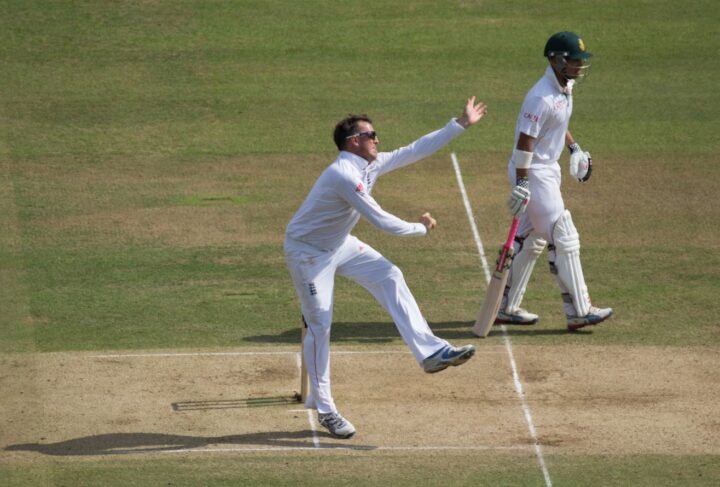Scenario one. An erratic spinner steps up to the crease and delivers a slow, waist-high full toss, which the batsman pulls away effortlessly for six. The umpire then raises his arm and signals no ball. The fielding captain complains. Who is in the right?
Scenario two. A medium pace bowler bowls another waist-high full toss, which hits the top of the stumps. The umpire makes no signal. The dismissed batsman complains. Again, who is in the right?
This thorny old issue – of no balls for height – is on my mind again after a weekend when it provoked yet another argument during a village cricket fixture. There is, quite simply, no law of cricket which causes so much controversy, ill-feeling and rancour. I’ve witnessed (and sometimes instigated) rows, histrionics and tantrums so intense that the two sides never again play each other.
You’d think that LBW – with all its subtleties of interpretation – would be the chief source of contention on a village cricket field. But there’s something about height no balls that really causes bad blood between teams, even though most arguments could easily be avoided by a quick glance at a copy of the lawbook.
This issue never seems to cause trouble in any other form of cricket, because only village bowlers regularly deliver huge full tosses. At higher levels of the game, bowlers usually manage to master the notoriously tricky business of getting the ball to land on the pitch. And that’s part of the reason the relevant law causes so many problems. It’s never explained on TV or during coaching, because so rarely does it arise in ‘proper’ cricket – unlike LBW, which is endlessly analysed and illustrated by commentators.
No ball for height also triggers ill-feeling because it seems to punish incompetence. It rubs your nose in it. For example, let’s say the batsman is past his half-century and going great guns. On comes a terrible bowler, who fires one high and wide, and the ball disappears for six. The extra ball and run for the no ball seem so unfair, because the batsman prospered from the inaccuracy of the delivery. Even worse, if the batsman is caught on the boundary, a no ball signal will reprieve him.
But the real driver of controversy is the widespread ignorance of the actual wording of the law. If the bowler is slow, a waist high delivery is not a no ball. It must be much higher – over the shoulders – to be an illegal delivery, unless the pace is medium or fast.
The key to interpreting the law governing height is to understand that its purpose is to discourage and outlaw dangerous play – specifically, the beamer – on grounds of safety and fairness. It is categorically not about the batsman’s ability to reach the ball (which is covered by the wides law). And that’s why it comes within the scope of Law 42.6: ‘Fair and unfair play – dangerous and unfair bowling’.
It reads as follows.
6. Dangerous and unfair bowling
(b) Bowling of high full pitched balls
(i) Any delivery, other than a slow paced one, which passes or would have passed on the full above waist height of the striker standing upright at the popping crease is to be deemed dangerous and unfair, whether or not it is likely to inflict physical injury on the striker.
(ii) A slow delivery which passes or would have passed on the full above shoulder height of the striker standing upright at the popping crease is to be deemed dangerous and unfair, whether or not it is likely to inflict physical injury on the striker.
In both cases, the umpire should call no ball.
So why is such a simple law so commonly mis-applied? The village umpire only needs to ask himself three questions.
1. Is the bowler slow?
2. Was the batsman standing either on or behind the popping crease?
3. Was the ball over waist/shoulder height?
Whether or not the bowler is slow is arguably a subjective question. But a good rule of thumb, I’d suggest, is the position of the keeper. If he’s standing up, the bowler is slow, and vice versa.
The original scenarios
In the first instance – the spinner hit for six – the grumbling captain is correct. The ball was perfectly legal. The second – bowled by a full toss – is more complex. In real life I’ve twice seen a high full toss hit the wicket; one was no balled, the other wasn’t. Because the bowler is medium pace, anything above the waist will indeed be a no ball. So the question is instead – can a cricket delivery’s trajectory take it over the batsman’s waist but still hit the stumps?
The maths are as follows. Cricket stumps are 28 inches high, and four feet from the popping crease. The average male waist is 42 inches above the ground. To be a no ball, but hit the wicket, the ball will need to fall 14 inches over four feet, or 3.5 inches per foot.
Is that consistent with the trajectory along which the ball has already travelled? Let’s assume the bowler is about six foot tall, and is a few inches in the air at the moment of delivery, with his arm directly above the popping crease at the non-striker’s end. This would mean the ball is released from a height of nine feet, 58 feet away from the batsman. To pass above his waist, the ball must fall by no more than 65 inches over 58 feet, or 1.12 inches per foot.
In other words, it sounds unlikely that a no ball could hit the stumps, because the trajectory has to change too much in the last four feet of the ball’s journey. But that assumes the players are exactly the heights I’ve described – and that my methodology is sound. Real life experience suggests that a full toss could indeed pass over the waist but still bowl the batsman. The square leg umpire needs to be aware of this possibility – and take note of where the batsman has taken guard. If he’s batting two feet in front of his crease, all bets are off, no ball-wise.
The solution
Some people say – why does it matter? Who cares if the odd extra is wrongly awarded by the umpire, by innocent mistake? To which I’d argue, you either all try and play by the same laws of cricket, or you don’t. If it’s acceptable for one umpire to mis-apply law 42.6, why shouldn’t another umpire mis-apply the law about the size of the bat, or handling the ball, or the number of players in each team? And is it unreasonable to expect regular village players to – at least once in their career – take a quick flick through the laws, which are online here at the MCC website.*
One useful course of action is for the captains to discuss the issue before the match, along with format, rules of engagement – to achieve a consensus. Maybe they can agree to ignore the height law completely, or all for all high deliveries to be no balls, regardless of pace. On the village green it matters less that the laws are fully observed, than that both sides agree to the same playing conditions – hopefully minimising the scope for argument and recrimination.
What do you think?
We’d love to hear your thoughts and experiences on this. When have no balls for height triggered an almighty rumpus? As an umpire or captain, how do you balance applying the laws with keeping the peace, but still stick up for yourself? Should the MCC change the law to make it easier to apply?
Get in touch and give us your perspective.
Maxie Allen
(Maxie is a former co-editor of The Full Toss. He founded the blog with copywriter James Morgan in 2009).
* Since this article was written the law surrounding no balls has changed. The speed of the bowler is no longer mentioned; therefore it seems that every delivery above waist high should therefore be called no ball. Here’s the MCC wording:
‘41.7.1 Any delivery, which passes or would have passed, without pitching, above waist height of the striker standing upright at the popping crease, is unfair. Whenever such a delivery is bowled, the umpire shall call and signal No ball’.









What if the batsman standing outside the crease ? And ball hits to hear